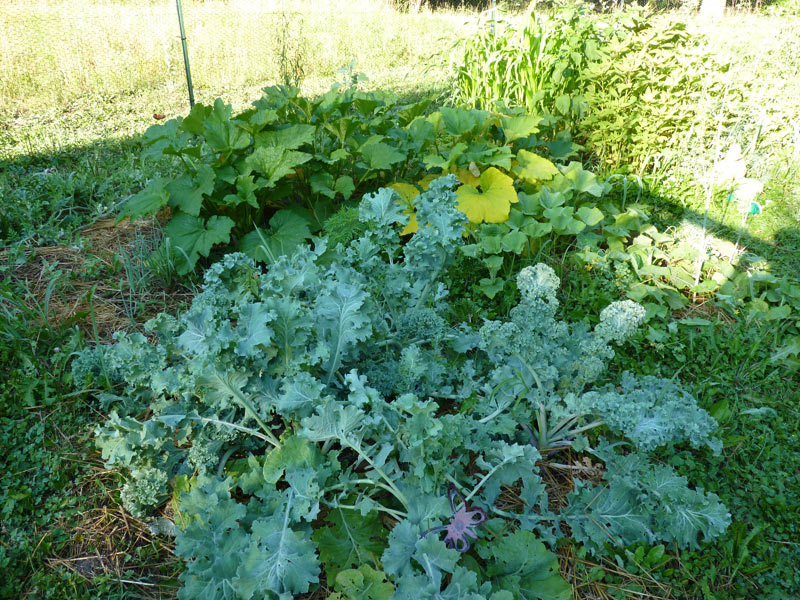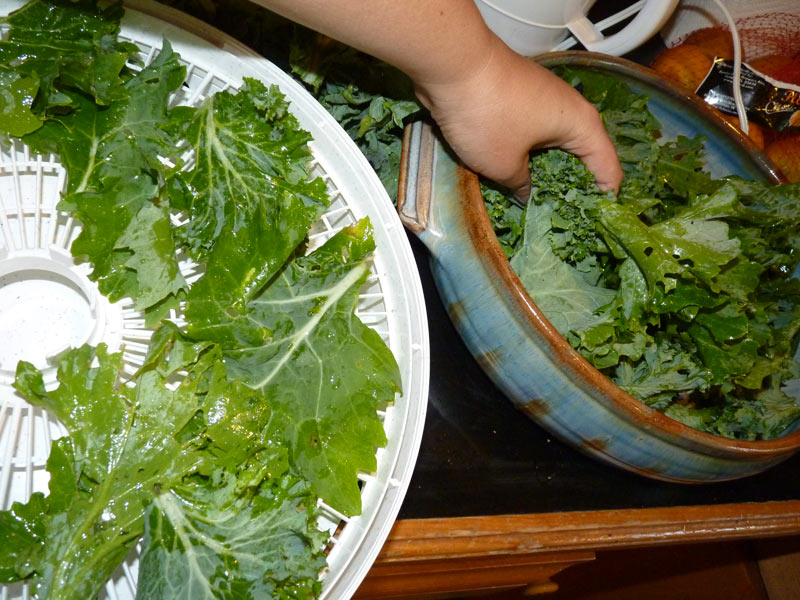Eating a locally-based, mostly plant diet is a key way of reducing your impact on our earth mother. Finding foods that are easy to grow, highly nutritious, easy to preserve, and harvestable for most of the year make eating sustainably easier.
I wanted to post about Kale, because its seriously an amazing veggie that everyone should know about. Kale is in the brassica family, and many varieties of the veggie are cold-hardy. Last winter, I had kale (uncovered) in my garden, still ready to pick, up until December 31st. In fact, it does very well in cold weather situations–but it can also take the heat. It also seems fairly resistant to slugs, bugs, and other things that like to chew up veggies. Kale is not resistant to groundhogs or rabbits though, so keep that in mind when thinking about planting it. I had really hoped to put it in my permaculture-based edible landscaped beds, but it just kept getting eaten so I now grow it in my vegetable garden.

Nutritionally, Kale is one of the best vegetables to eat. Period. A cup of Kale (raw) has 36 calories, 5 grams fiber, and a slew of vitamins (180% of your recommended vitamin A; 200% vitamin C; 1000% vitamin K, 5 grams fiber, 40% of magnesium, and 15% calcium and vitamin B6 plus other trace minerals). Researchers have shown Vitamin K to be linked with cancer-prevention, making it amazing to eat!
I’ve been growing two varieties of kale for the last few years: Siberian Kale (despite the name, not as cold hardy) and Red Russian Kale (cold hardy to -10, although mine last year died at about 0 degrees Fahrenheit even being well-mulched; I think it was wind). Kale is really easy to grow. I usually start it indoors (in my Zone 6 climate, this means I start it at on Feb 1st and usually transplant it by early to mid-March).
Despite its health benefits, not everyone enjoys the taste of kale. I like to use it in stir fries, soups, and also in chip form. Here’s my recipe for homemade Kale chips–I hope you enjoy! You can put the chips in a bag and store for quite a long time.
Homemade Kale Chip Recipe: Balsamic Flavor
- 1lb or so of kale, cleaned with stems removed, torn into pieces not larger than 5″ across
- 2 tbsp of good quality olive oil
- 2 tbsp of good quality balsamic vinegar (you can use raspberry-flavored vinegar for extra flavor)
Mix all of your ingredients in a large bowl. Try to coat your kale completely with the oil and vinegar–this will make your chips nice and crunchy.
Dehydrator method: Put your kale chips in a dehydrator (either a solar powered one, if you have one) or a regular one. Dehydrate for 5-6 hours, turning them once. If you want to keep these “raw” you can dehydrate at 105 degrees (which I do when making them for my cousin, who is a raw vegan).
Oven method: You can bake them 10-15 minutes (turning once) at 350 degrees.

Here are some other recipes for kale chips:
Homemade Kale Chip Recipe: Herb and Garlic
- 1lb or so of kale, cleaned with stems removed, torn into pieces not larger than 5″ across
- 2 tbsp of good quality olive oil
- 1 tbsp or more herb blend (italian, herbs de province, etc.)
- 2 tsp powdered garlic (less or more, depending on your flavor preferences)
- 1 tsp salt
- 1 tsp fresh ground pepper
Homemade Kale Chip Recipe: Fat Free
If you are on a fat free diet, you can omit the oil above and instead add a splash of vinegar or citrus. The chips won’t be as crunchy without the oil, but you’ll still have the delicious taste and nutritious benefits!




I love my kale chips with a touch of vinegar and sea salt.